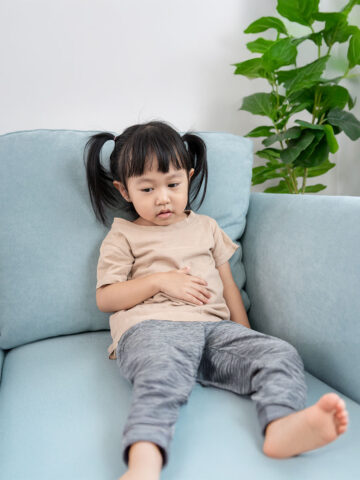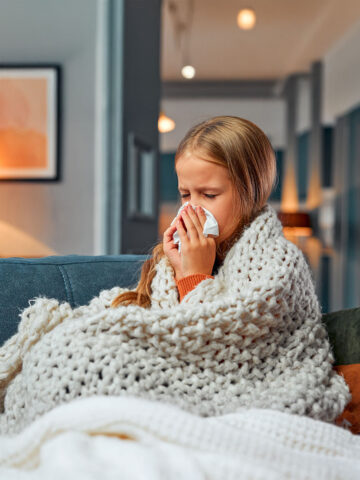Tips for reducing your carbon footprint
Many parents have probably heard climate change being talked about in the news, and it can feel scary and overwhelming. You may be asking yourself: What exactly is climate change? How might it impact me and my family?
Dr. Michele Domico, a pediatric critical care specialist and member of CHOC’s Sustainability Task Force, has answers.
Here, she talks about how climate change can impact kids and future generations, and what we can do today to help slow global warming and climate change.
“Talking about climate change can feel like doom and gloom,” says Dr. Domico. “But our Earth is resilient! We just need to give it a chance to heal and regenerate.”
How can climate change affect children’s health today, and over time?
As many of us may have heard, instances of extreme weather — like wildfires, heat waves and droughts — are becoming more frequent and longer-lasting.
“Until we take global action to combat global warming, the severe weather events will unfortunately become worse over time,” says Dr. Domico.
These extreme weather patterns are linked to increased carbon emissions released into the atmosphere from human activities like driving cars, energy consumption, processing meat and producing non-recyclable waste.
Over time, as mean global temperatures rise, there may be an increase in vector-borne diseases (which are caused by the bites from insects like mosquitos or ticks), that thrive in warmer climates. This includes diseases such as Lyme disease and West Nile Virus.
Read more about climate change and vector-borne diseases.
Here in Southern California, prolonged heat waves are becoming more common during the summer months.
Of course, extreme weather and excessive heat can be dangerous for children’s health no matter where they live. Excessive heat can lead to more kids getting heat stroke and other heat-related illnesses.
How to spot signs of heat-related illnesses in kids
Heat stroke can be especially common in young athletes. It’s the third leading cause of death – behind sudden cardiac arrest and traumatic brain injuries – in U.S. high school athletes.
Parents need to keep an eye on their kids during hot weather, especially when spending time outdoors or playing sports. Look for the following signs of overheating in kids:
- Increased thirst.
- Weakness.
- Irritability.
- Headache.
- Dizziness or fainting.
- Muscle cramps.
- Nausea and/or vomiting.
- Increased sweating.
- Cool, clammy skin.
- A raised body temperature, but less than 104°F (40°C).
Proper hydration, taking breaks in cool indoor environments and limiting outdoor activities during peak heat hours can help prevent health-related illnesses in kids.
Learn more about how to keep kids cool during hot weather from CHOC.
How does air pollution affect kids?
According to a recent report by the American Lung Association, more than one-third of people living in the United States — 119.6 million people — live in places with unhealthy levels of air pollution.
Unfortunately, breathing unhealthy air can exacerbate asthma, allergies, and other respiratory illnesses, and put children at a greater risk for developing chronic lung disease.
Wildfires may also lead to high levels of air pollution in areas affected, which can cause symptoms in kids such as chest tightness or pain, shortness of breath, wheezing, coughing, burning or stinging of the nose, throat and eyes, and dizziness or lightheadedness.
Learn how you can protect your kids from the health effects of wildfires.
Are some kids more at risk for experiencing the harmful effects of climate change and pollution?
Yes. There are many social inequities (injustices) related to climate change, says Dr. Domico.
Oftentimes, the countries and communities that are the least responsible for creating carbon emissions are the most negatively affected by climate change. They may not have infrastructure and systems in place for early warning signs of extreme weather, and when something like a wildfire, hurricane or cyclone happens, entire communities can be destroyed.
Even in the United States, some communities are more negatively impacted by climate change than others. Many factors can impact someone’s health such as unsafe housing, economic stability, and access to clean water, health care and healthy food.
In some areas, being healthy can be much harder for families, and extreme weather conditions can be life-threatening. For example, extreme heat can be dangerous for families who don’t have access to an air-conditioned space to cool off.
Is there anything parents can do to help protect their kids from climate change?
Yes, there are simple things that parents can keep in mind to protect their kids from the impact of local extreme weather events. Dr. Domico suggests the following:
Be aware of local weather forecasts.
Have a plan for your family if extreme weather is coming. If a heat wave is coming, find a place where you can cool off, many indoor public spaces such as shopping malls and libraries have air-conditioning. Energy blackouts can occur particularly during summer months, so make sure you have a way to use any necessary medical equipment with an offline power source such as a battery back-up.
Have a plan in place for children who may be at risk for respiratory issues caused by air pollution.
Talk to your pediatrician about how to prevent respiratory problems in your kids with asthma, allergies or weakened immune systems that are caused by poor air quality or wildfires. Think of what your child may need ahead of time – such as refills to their medications — and have those on hand.
What should we all be doing to help slow climate change?
During the 2015 Paris Agreement, every country in the United Nations agreed to work together to limit the mean global temperature rise to below 1.5 degrees Celsius. To accomplish this, we need large-scale changes to rapidly reduce carbon emissions, says Dr. Domico.
Although this can feel overwhelming, there are small things that parents can do at home to help accomplish this goal. Parents shouldn’t feel like they must go out and buy an electric car or solar panels; there are simple changes that you can start today that can make a difference over time.
Easy ways that parents can help reduce climate change at home:
- Repurpose items. Before throwing an item away that you don’t need anymore, consider giving it a new purpose, gifting it to someone else or donating it.
- Reduce waste. Turn down single use plastics like straws and utensils. Carry your own reusable utensils and water bottle.
- Recycle your cardboard, aluminum and plastic bottles.
- Change the setting on your thermostat to one degree higher (in the summer) or one degree lower (in the winter) to save energy.
- Walk or ride a bike when taking short trips instead of driving.
- Incorporate more plant-based meals into your diet. Consider doing “meatless Mondays” once a week to try out a vegetarian meal with your family. The beef industry produces a large amount of greenhouse gas emissions and is a major contributor to deforestation (trees being cut down to make room for cow pastures). Find out more about beef and climate change.
What else should parents know about climate change?
Dr. Domico points out that, “Surprisingly, the healthcare system in the United States is responsible for 8.5% of our country’s carbon emissions. That’s more than the airline industry, which produces 2%!”
Because of this, at CHOC, we feel a tremendous responsibility to do our part to help lower this number. As defenders of childhood, we care about protecting the health of our kids, and our planet. To protect the health of children now and in the future, we need to pay attention to our environment.
CHOC recently formed an Environmental Sustainability Task Force, which is in the early stages of developing a plan to reduce the hospital’s carbon footprint. CHOC’s Sustainability Task force includes a diverse group of executive leaders, doctors and key hospital staff from different departments dedicated to making a difference by protecting our natural resources for future generations.
Remember: The Earth is resilient! Just by reading this article, you are already doing a great job. If we all started making Earth friendly choices, even small changes, we can slow global warming. All these actions add up to make a huge difference. It won’t happen all at once, but if we work together, we can protect our kids and set them up for bright futures, says Dr. Domico.
For more health and wellness resources from the pediatric experts at CHOC, sign up for the Kids Health newsletter.
Find a CHOC Primary Care Pediatrician
From babies to teens, pediatricians from CHOC’s Primary Care Network partner with parents to offer immunizations, sick visits, sports physicals and more.






